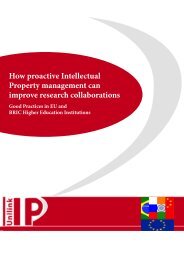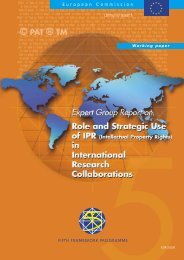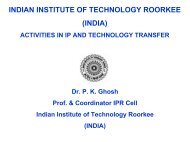Management of intellectual property in publicly-funded research
Management of intellectual property in publicly-funded research
Management of intellectual property in publicly-funded research
- No tags were found...
You also want an ePaper? Increase the reach of your titles
YUMPU automatically turns print PDFs into web optimized ePapers that Google loves.
The difference is attributed to the comb<strong>in</strong>ation <strong>of</strong> several factors:• Most European PROs have a relatively low number <strong>of</strong> patents compared to their UScounterparts, not because the science <strong>in</strong> the US is better, but because <strong>of</strong> a largerpropensity to file patent applications. In addition, the US patent system is reportedly 5times less expensive than the patent system <strong>in</strong> Europe.• There is also a time lag effect, s<strong>in</strong>ce the US PROs have been encouraged to patent s<strong>in</strong>cethe passage <strong>of</strong> the Bayh-Dole Act whereas the <strong>in</strong>terest for European PROs to managetheir IP is only recently start<strong>in</strong>g to spread;• The demand for licenses from PROs is also larger from US companies than fromEuropean companies because <strong>of</strong> a larger domestic market and a more active network <strong>of</strong>technological SMEs backed by venture capital. Indeed the problem fac<strong>in</strong>g us could evenbe described as be<strong>in</strong>g a surfeit <strong>of</strong> potentially great new technologies, which because theycome from PROs are too early to warrant <strong>in</strong>dustrial <strong>in</strong>vestment. The recently publishedLambert Report from the UK 19 <strong>in</strong>dicates one other reason for the lack <strong>of</strong> <strong>in</strong>dustrialuptake, namely the dearth <strong>of</strong> technology-dependant (<strong>research</strong>- active) <strong>in</strong>dustries <strong>in</strong>Europe. For those that are around, very <strong>of</strong>ten the risks are just too high.• The fund<strong>in</strong>g <strong>of</strong> PRO <strong>research</strong> by US government is significantly larger than <strong>in</strong> Europe,both <strong>in</strong> absolute terms and <strong>in</strong> relative terms, with the US government fund<strong>in</strong>g more than90% <strong>of</strong> all PRO <strong>research</strong>.Therefore we need to f<strong>in</strong>d ways <strong>of</strong> gett<strong>in</strong>g more development fund<strong>in</strong>g <strong>in</strong> order to weed outtechnologies that truly have no commercial application, thus ensur<strong>in</strong>g that if the pro<strong>of</strong> <strong>of</strong> pr<strong>in</strong>cipledoes work there is a greater likelihood <strong>of</strong> an <strong>in</strong>dustrial partner runn<strong>in</strong>g with the development. This callfor a more strategic relationship with not just traditional <strong>in</strong>dustry (see chapter 4 below) but with otherstakeholders, such as local economic development agencies and VCs (see chapter 5 below).3.2. General Pr<strong>in</strong>ciples <strong>of</strong> PRO licens<strong>in</strong>gTechnology Transfer from PROs <strong>in</strong>to the <strong>in</strong>dustrial environment has traditionally adopted a licens<strong>in</strong>gmodel. The PRO grants user rights to its <strong><strong>in</strong>tellectual</strong> <strong>property</strong> <strong>in</strong> the form <strong>of</strong> a licence, which can beexclusive, with or without the right to sublicense, which enables the <strong>in</strong>dustrial partner to develop andcommercialise covered products and/or processes <strong>in</strong> return for licence fees and/or royalty <strong>in</strong>comerelated to the commercial returns achieved by the <strong>in</strong>dustrial partner. There are a number <strong>of</strong> reasonsfrom the PRO perspective why this is a desirable model.Firstly there is no susta<strong>in</strong>ed dilution <strong>of</strong> the Intellectual Property Rights <strong>in</strong>clud<strong>in</strong>g know-how andmethodology which reflect the vast expertise developed and acquired by the PRO ResearchDepartments over many years, supported by a broad range <strong>of</strong> <strong>research</strong> sponsors.Where new technology is identified then PROs are obliged to ensure that appropriate development anddownstream use can be made <strong>of</strong> the early stage technology rather than it sitt<strong>in</strong>g locked away <strong>in</strong> auniversity laboratory or alternatively perhaps be<strong>in</strong>g sold or licensed to a company, which does notproactively develop or make use <strong>of</strong> the technology. Therefore, by enter<strong>in</strong>g <strong>in</strong>to a License Agreement,the University establishes a direct partnership with the <strong>in</strong>dustrial partner, which means that there canbe a dialogue about the use <strong>of</strong> the technology and its potential as a commercial product or process. In19 “Lambert Review <strong>of</strong> bus<strong>in</strong>ess-university collaboration” – http://www.hmtreasury.gov.uk/media//06729/lambertemerg<strong>in</strong>gissues_173.pdf26







